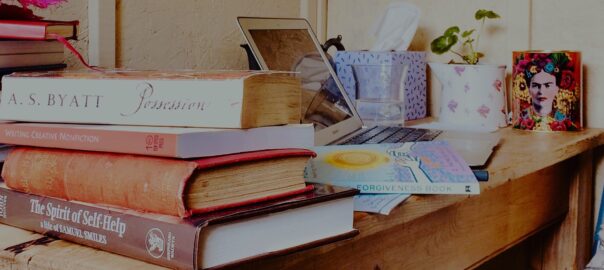In August I published a blog post entitled ‘Book Harvest’, in which I observed how much I enjoy reading at any time of the day and pretty much anywhere. Whilst this still applies, I’ve found it difficult to concentrate on my reading in recent weeks, due to discombobulation brought about by various happenings on the home front as we accelerate our longer-term plan to seek a new home and studio in Lincolnshire. Things have now settled down and I’m pleased to have completed my book club reading for this month; ‘My Sister the Serial Killer’ (2018) by Oyinkan Braithwaite, ‘A Ladder to the Sky’ (2018) by John Boyne and ‘The First Men in the Moon’ (1901) by H.G. Wells. A broad selection, to say the least. I’ve now started ‘The Rapture’ (2019) by Claire McGlasson, a novel keenly anticipated since I attended an interview with the author at St Neots Library in September, facilitated by Jacqui from the town’s branch of Waterstones.
Rapid Reading
That restless feeling brought to mind a second-hand book I purchased in July entitled, ‘Rapid Reading’ (1964) by Geoffrey A. Dudley, B.A. (b1917), part of a haul from the wonderful Torc Books in Snettisham, Norfolk.

In his rather quaint and dated fashion, Dudley aims to equip readers with the ability to read material of any kind, rapidly and with comprehension, for business, for study or for relaxation. He lists the benefits of rapid reading e.g.
Rapid reading saves time: it enables you to avoid constantly having to renew your library books or being tempted to keep them beyond the allotted time and having to pay a fine when you do eventually return them.
(This is not a problem for me today but when the children were small I did take the liberty of stealing unauthorised extensions to their book borrowing. Violating the library code somehow seemed more acceptable when it came to the supply of reading material for the little ones. The fines, which I paid of course, were stacked up on THEIR library dossiers.)
Rapid readers keep up with the Joneses: it enables you and your family to keep up with the Joneses by showing that you are the equal of any other person who reads rapidly.
(Intellectual snobbery is an unbecoming trait, often exhibited by those who lack scholarly credentials and sometimes by those who don’t. I like to imagine The Two Ronnies practicing one-upmanship in rapid reading.)

Rapid reading gives you prestige and popularity: it gives you a greater opportunity to pass on what you learn to other people. You thus gain prestige and popularity.
(And a reputation as a smart alec.)
Dealing with distraction
Dudley says that before one can learn to read faster one must first learn to concentrate, and in order to do so one must deal with any distractions. These include ‘outer’ and ‘inner’ distractions, loss of interest in the subject matter and a conflict between imagination and will. His practical hints on removing obstacles to concentration include:
- Satisfy your eating and drinking requirements and give attention to the call of nature before you embark upon a piece of reading;
- Remedy excessive day-dreaming by arranging one’s life so as to achieve greater satisfaction in reality; and
- Deal with emotional conflict, which interferes with concentration more than anything else.
Dudley took an interest in self-improvement and in dreams, writing several publications on these topics such as, ‘How to be a good talker: a practical self-instruction programme for effective self-improvement’ (1971), ‘Double your learning power: master the techniques of successful memory and recall’ (1986) and ‘How to Understand Your Dreams’ (1957). His book on, ‘Your personality and how to use it effectively’ (1996) appeals. Many of his books were published as mass-market paperbacks or pocketbooks, cheap editions sold in convenience stores, supermarkets and airports.
Dudley’s readers in 1964 would not have had the additional distraction of network tools online such as Facebook, Instagram and Twitter or indeed, email. The American academic Cal Newport admits that knowledge work (which is what I do) is dependent on ubiquitous connectivity which generates a, ‘devastatingly appealing buffet of distraction—most of which will, if given enough attention, leach meaning and importance from the world constructed by your mind’.
Ah yes, Professor Newport. Knowledge workers, or ‘edutainers’ like me, do indeed spend much of our working day interacting with these ‘shallow concerns’.
My son, George, a bona fide knowledge worker, does not use social media at all and introduced me to Newport’s writing by recommending, ‘Deep Work: Rules for Focused Success in a Distracted World’ (2016). Like Dudley, Newport declares that the ability to concentrate intensely is a skill which must be learned and regularly exercised. He recognises that undistracted concentration is treated as a habit, like flossing, ‘something that you know how to do and know is good for you, but that you’ve been neglecting due to a lack of motivation’. This implies you can easily switch from distraction to focus, thereby ignoring how difficult it is to focus properly and how much you need strengthen your ‘mental muscle’ through practice.

Dudley suggests we try ‘negative practice’ developed by the American psychologist, Dr Knight Dunlap (1875–1949). This involves setting aside say, five minutes at a time for twice a day, in which you deliberately practice the undesirable habit you want to overcome. When applied to day-dreaming or worry, you should sit down and deliberately let your mind wander or force yourself to worry. As you observe doing this you should tell yourself that you are doing it with the aim of breaking yourself of these habits which impair your concentration. You’re likely to find that if you keep on with this practice you will eventually realise that day-dreaming and worry are not in your best interests.
Dudley says we can break the vicious circle of day-dreaming or worry and turn it into the straight line of positive thought and action. Newport recommends we practice ‘productive meditation’ by focussing our attention on a single well-defined professional problem such as outlining an article or writing a talk, whilst undertaking some physical activity; walking, jogging, showering and even driving. This could perhaps be an alternative to negative practice, by simply turning your attention to a more constructive topic no matter what you’re doing.
For me, as a period of intense work progresses, aspects of the project constantly percolate in my mind, no matter what else is going on. Even with a longer-term venture such as the part-time doctorate I finally completed in 2015, eureka moments were somehow distilled from the mash of daily existence.
Rapid writing
It’s some time, however, since I’ve had a spell of regular intense writing, the last of which resulted in ‘The Curious History of Mazes’ (2018). Having a tight schedule set by the publisher helps to focus the mind. This year I’ve instead been using the extended writing time for reading, and have finished 71 books to date. Although, as we fast approach the beginning of NaNoWriMo, the annual writing fest open to writers everywhere, I’m seriously considering signing up as an excuse to focus on a particular non-commissioned project. I’m booked on the Cambridge Writers HQ Retreat, 9 November, and I’ve listened to a few ‘Preptober’ podcasts on how to approach NaNoWriMo, including advice from the best-selling ‘authorpreneur’, Joanna Penn. I appreciate it’s going to take more than that to reach the standard NaNoWriMo 50,000-word target.

Who am I kidding? No way am I going to write that many words in one month.
Still, at least for the next few weeks I’ll have a better chance of shutting out any distractions caused by the prospective relocation and de rigueur family bickering about arrangements for the season of goodwill.
Good luck to all those participating in NaNoWriMo 2019.




